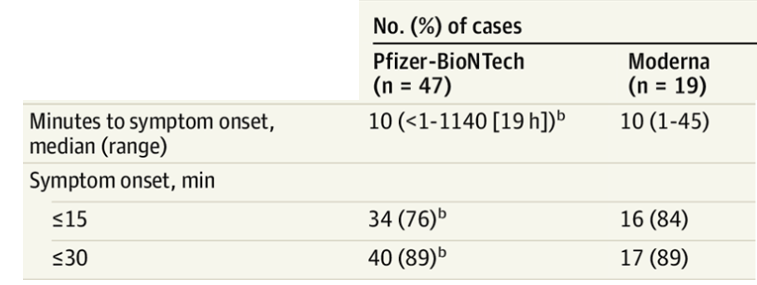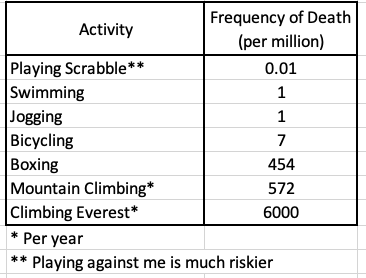Sorry, anti-vaxxers. If you're hoping to find some bad news about the COVID vaccines, you've come to the wrong site. Perhaps you should try AlienDNA.com, or I'm out of my F#####Mind.org. I've got nothing but good news.
The good news comes to us thanks to a new paper in JAMA Insights. Tom Shimabukuro, MD, MPH, MBA, at the CDC Immunization Safety Office, and colleagues evaluated the chances of vaccine recipients developing anaphylaxis following a shot. It should put you at ease; anaphylactic reactions to both the Pfizer or Moderna COVID vaccines are very rare. More than 17 million vaccines were administered, and only 66 people suffered a reaction.
Time Interval Between Injection and the onset of anaphylactic symptoms

It is no accident that you need to wait around for 15 minutes following your shot. As is the case with most anaphylactic reactions, they happen fast. The median time until onset for both vaccines was 10 minutes. More than 75% of the people who got a reaction developed it within 15 minutes and about 90% within a half-hour (source for this and subsequent figures JAMA Insights).
The First Shot is Riskier than the Second
It is not surprising that people who developed symptoms did so much more frequently after the first shot than the second:

...or that the people who ran into trouble had a history of allergic reactions in the past (1).

The Bottom (and Very Good) Line - An Excellent Safety Profile

If you're worried about a bad reaction to the vaccine, this should put your mind at ease. The incidence of anaphylactic reactions was very low – 4.7 per million (0.00047%) for Pfizer and 2.5 per million (0.00025%) for Moderna. These are not the kind of numbers you should be worried about. To put this in context (and for some yuks), here are some common activities and the risk of dying.

Source: Mental Floss
Don't take this too seriously. It's a comparison of dying from a completely unrelated set of activities and a reaction to a vaccine. But it points out how unlikely you are to have a serious reaction to either vaccine; it's a bit riskier than jogging and a bit less risky than bicycling. Most people don't give either of these a second thought.
So based on data from more than 17 million shots, your chances of an anaphylactic reaction are vanishingly small.
What Happened to the People Who Ran Into Trouble?
There is good news here as well. Of the 66 people (17 million shots) who had reactions, 92% received emergency epinephrine treatment; half were treated in the ER, and half were admitted. Seven people required intubation; no one died. And keep in mind that more than three-quarters of this group had a history of allergies or prior anaphylactic episodes. For the rest of us, the chance of running into this problem is close to zero.
So, don't worry. Relax and go for a jog or a swim and go get vaccinated. Just be extra careful if you bike there.
NOTES:
(1) The allergic triggers included about 20 substances, including vaccines, drugs, latex, and nuts.
(2) In this article I am only reporting on anaphylaxis and only in the US. Since 193 million shots (across the world) have been given, small numbers of other adverse reactions, even deaths could be possible. And very unlikely.




